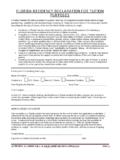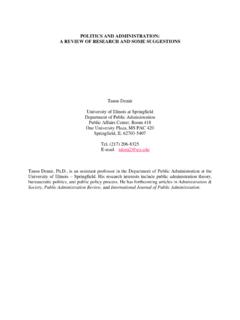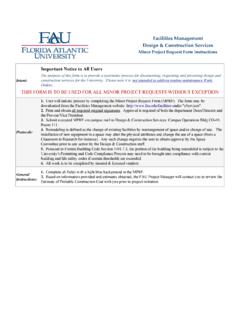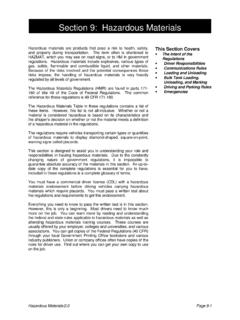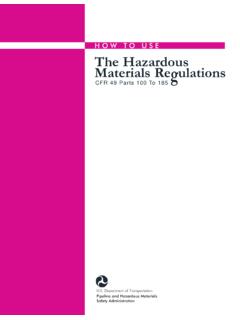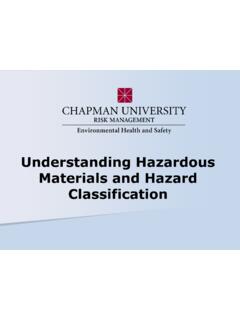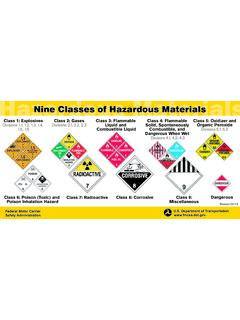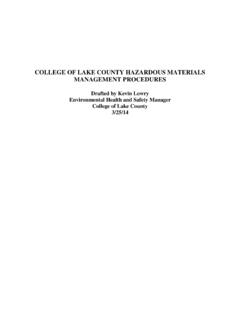Transcription of HAZARDOUS MATERIALS MANUAL
1 HAZARDOUS MATERIALS MANUAL B-1 Purpose The purpose of this policy is to provide University faculty, staff, and students with guidance in the safe and proper storage, handling and disposal of HAZARDOUS MATERIALS . While this document does not cover all regulatory requirements concerning the handling, storage and disposal of HAZARDOUS MATERIALS , it provides the basic information necessary for most laboratories to comply with applicable regulations. Additional information is available in the references listed in Appendix F. Contact Environmental Health and Safety for help in accessing the references. B-2 Definition of HAZARDOUS MATERIALS A HAZARDOUS material is a substance, which is capable of producing harmful physical or health effects. Harmful physical effects include: fire, sudden release of pressure, explosion, and other violent reactions. Harmful health effects include: acute conditions and chronic conditions. Acute conditions develop soon after an over-exposure to HAZARDOUS MATERIALS and include: burns, rashes, respiratory distress, convulsions, and possibly even death.
2 Chronic conditions develop after long term exposure to HAZARDOUS MATERIALS and include; cancers, nervous system disorders, and damage to other organ systems. B-3 Classification of HAZARDOUS MATERIALS In order to safely handle and store HAZARDOUS MATERIALS , it is important to know the hazards. The hazards of most MATERIALS fall into one or more of the following classifications: Flammable Liquid Generally, any liquid that produces enough vapor at a temperature less than or equal to 140 oF ( oC) to ignite when exposed to an ignition source. In the United States, the legal definition of a flammable liquid has different meanings from agency-to-agency as follows: DOT defines a flammable liquid as any liquid having a flash point of not more than 141 F ( C), or any material in a liquid phase with a flash point at or above 100 F ( C) that is intentionally heated and offered for transportation. OSHA defines a flammable liquid as any liquid having a flashpoint below 100 F ( C), except any mixture having components with flashpoints of 100 F ( C) or higher, the total of which make up 99 percent or more of the total volume of the mixture.
3 EPA uses the term ignitable rather than flammable, and defines it as a liquid, other than an aqueous solution containing less than 24 percent alcohol by volume, and has flash point less than 140 F (60 C), Note that a chemical might not be labeled as flammable under the auspices of OSHA; however, it may still meet the definition of flammable or ignitable as defined by DOT and EPA, respectively. Combustible Liquid Any liquid which has a flash point between 141 oF ( oC ) and 200oF ( ). Flammable Solid A substance that can cause a fire through friction, absorption of moisture or spontaneous chemical changes and, when ignited, will burn so vigorously that it creates a hazard sodium borohydride, coal, etc. Oxidizer A substance that readily yields oxygen or other electron acceptor to stimulate the combustion of organic matter (fuel) nitrates, permanganates, etc. Corrosive A liquid that corrodes steel (SAE 1020) at a rate greater than mm ( in.) per year at a test temperature of 130oF (55oC) or has a pH less than 2 or greater than acids, bases, anhydrides, etc.
4 Organic Peroxide An organic compound containing the chemical bond -0-0- (oxygen joined to oxygen). Poison A substance so toxic that it presents a risk to life or health. Explosive Any chemical compound, mixture or device that reacts or decomposes with substantial instantaneous release of gas and heat. Compressed Gas A substance in gas or liquid form contained in a vessel under pressure. This includes cylinders, lecture bottles, and aerosol cans. These substances may be flammable, non-flammable, or poisonous. Cryogenics Substances which are extremely cold such as liquid nitrogen, liquid helium and dry ice. These substances can displace air and may become asphyxiation hazards if spilled in non-ventilated areas. Radioactive Any material that contains atoms which are unstable and attempt to become more stable by ejecting alpha particles, beta particles, gamma rays, x-rays, neutrons, high-speed electrons, high-speed protons, and other particles capable of producing ions.
5 Examples of radioactive waste MATERIALS include: (1) solid waste; such as, contaminated PPE and glassware, scintillation vials, plastic ware, paper, gels, animal carcasses, and plant tissue and- (2) liquid waste; such as, scintillation cocktails, electrophoresis gels, and discarded stock radioisotopes. See the FAU Radiation Safety MANUAL for specific information on the generation and proper disposal of radioactive material . Biomedical/Biohazards Tissues, organs, and blood from humans and primates. Syringes, needles, sharps, and other objects containing MATERIALS above. B-4 HAZARDOUS MATERIALS Training Requirements Laboratory personnel working with any of the mentioned HAZARDOUS MATERIALS must receive Laboratory Safety Training. EH&S provides general Laboratory Safety Training. The Principal Investigator or Lab Manager is responsible for training other lab personnel about specific hazards and Standard Operating Procedures in their areas.
6 Federal and State regulations may require other training, such as Hazard Communication, HAZARDOUS Waste Disposal and Bloodborne Pathogens. These are offered by EH&S. Radiation Safety training is available from the Radiation Safety Officer. See the section Employee Information and Training for more information. B-5 Storage and Handling of HAZARDOUS MATERIALS HAZARDOUS MATERIALS must be stored based on their compatibility, not in alphabetical order. Store MATERIALS of the same hazard together flammables with flammables, oxidizers with oxidizers etc. Refer to the section on Proper Storage and Handling of Chemicals in the main body of the CHP and Appendix D: Storing Chemicals Safely for additional guidelines. B-6 Accidents, Spills, and Emergencies HAZARDOUS chemical spills can be handled effectively when a plan of action has been developed. For accidents, emergencies and spill awareness and/or procedures see Appendix G: HAZARDOUS MATERIALS Emergencies and Spills. B-7 Disposal of Chemical HAZARDOUS MATERIALS Federal, state and local laws strictly regulate the disposal of HAZARDOUS MATERIALS .
7 The disposal of any HAZARDOUS material in the sewer, on the ground or in the regular trash is illegal. See the EPA List of HAZARDOUS Waste section and the City of Boca Raton Sewer Use Policy at the end of this appendix for additional information. EH&S is responsible for collecting HAZARDOUS waste and preparing it for shipment to an approved HAZARDOUS waste disposal facility. Waste storage containers must be non-leaking, chemically compatible, safe, and clearly labeled with the words HAZARDOUS Waste. The label must also include the complete name(s) of the container s chemical constituents. Call EH&S for pickups and include the following information: the name of the products to be picked up, the location, the person in charge of the area, a phone number, and the quantity to be picked up. Lab workers can also fill out the Waste Pickup Request Form (which duplicates this information) and send the completed form to EH&S.
8 B-8 Disposal of Empty Containers HAZARDOUS chemical containers cannot be discarded until they are considered empty. In order to be considered empty, containers holding acutely HAZARDOUS "P" waste (see the EPA List of HAZARDOUS Waste at the end of this appendix) must be tripled rinsed and the rinsate must be collected and disposed of as HAZARDOUS waste. This can create much more waste than just disposing of the container as a HAZARDOUS waste when empty. Call EH&S for pickup of the container and do not put this type of container in the normal waste stream. Compressed gases including, non-returnable cylinders, and aerosol cans are not considered empty until they reach atmospheric pressure. EH&S will dispose of these types of cylinders. Empty Aerosol cans must be managed according to the requirements in the Special Waste section. Other HAZARDOUS chemical containers less than 110 gallon capacity are considered empty when as much material as possible has been removed through ordinary means (pouring, pumping, scraping, etc.)
9 , and there is less than 3% by weight of the original contents left in the container. Once these types of containers are empty, rinse out the container, let it air dry (preferably in a hood), and finally remove or deface the label prior to recycling or placing in the regular trash. B-9 Disposal of Ink and Toner Cartridges If an ink or toner cartridge has been used under normal circumstances until it is empty, it is not considered HAZARDOUS waste and can be managed by one of the following means: 1. Email Lillian Silva at . You will receive a container to store all your empty cartridges. When they are full, all you have to do is send another email and they will recycle them for you. 2. Ship the container back to the supplier for reclamation or reuse. Many companies now provide free containers and shipping (Xerox, HP). Whenever possible, unused or defective cartridges should be returned to the supplier for replacement or credit. This practice minimizes the amount of unused cartridges needing disposal.
10 Any cartridges that cannot be returned and still contain residual ink or toner that is determined to be HAZARDOUS waste must be picked up by EH&S for proper disposal. Contact EH&S for assistance if you are uncertain of how to properly dispose of any unused or defective ink or toner cartridges. B-10 Biomedical Waste Disposal Personnel who handle biomedical waste, sharps or work in areas which handle human blood, tissues and body fluids must comply with the policy and procedures for the handling and disposal of biomedical waste as required by the Florida Administrative Code, 64-E16. The regulation requires, among other things, waste containment, marking and labeling, and disposal of potentially contaminated material . For specific disposal information refer to the Biological Waste Program MANUAL or call EH&S. B-11 Disposal of Radiological Waste Only Authorized Use Supervisors may purchase and use radioactive material in a designated laboratory. Disposal of radioactive waste must be in compliance with 64E-5 and with the rules contained in the FAU Radiation Safety MANUAL .





